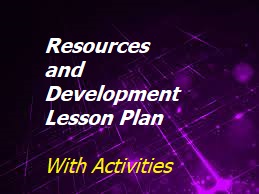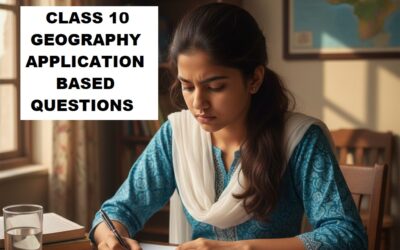Resources and Development Lesson Plan: Activity Based
Resources and Development Lesson Plan includes the various natural resources available on our planet and how they can be used sustainably for development. The Resources and Development Lesson Plan covers topics such as the classification of resources, their distribution and utilization, conservation and management of resources, and sustainable development. It also deals with the impact of human activities on the environment and the measures that can be taken to mitigate them.
This Lesson Plan on Resources and Development deals with the interdependence of various resources and the need for their judicious use. The lesson plan also highlights the importance of preserving resources for future generations and the role of individuals, communities, and governments in achieving sustainable development through activities.
Resources and Development Lesson Plan: Activity Based
Topic: Resources and Development
Class X
No. of Periods required: 7-8
General Objective:
- To create interest in the subject.
- To understand the importance of resources.
Specific Objective:
The objective of teaching Resources and Development to class X students is to:
- introduce the concept of resources and their types to students, including natural, human, and capital resources.
- make students aware of the importance of sustainable use of resources and the impact of overuse on the environment.
- teach students about the distribution of resources across the world and the factors that influence their distribution.
- help students understand the concept of resource planning and its importance in sustainable development.
- familiarize students with the various methods of conservation of resources, such as reuse, recycling, and reducing waste.
- enable students to identify the natural resources available in their local area and their uses.
- develop students’ critical thinking skills by analyzing the impact of resource use on the environment and society.
- educate students on the role of technology in resource development and its impact on society and the environment.
- encourage students to take responsibility for sustainable resource use in their daily lives and future careers and to
- prepare students for further studies in geography, environmental science, or related fields
Teaching Points:
- Definition of resource
- Types & Classification of resources
- Development of resources
- The concept of Sustainable Development
- Resource Planning
- Resource planning in India
- Land Resources
- Land use pattern
- degradation and conservation of land
- Soil as a resource
- Classification of soils
- Soil erosion and conservation
Teaching Aids:
- Physical and Political map of India.
- Map of soils.
- Audio and videos
- PPT
- Blackboard and chalk.
Checking Prior Knowledge:
Before starting the chapter, the teacher checks the prior knowledge of the students about resources by asking a few questions:
- What is meant by the term ‘natural resources’?
- Can you give examples of renewable and non-renewable resources?
- Do you know what is meant by sustainable development?
- How do human activities impact the environment and natural resources?
- What will happen if there is an over-exploitation of natural resources?
Teaching Methodology:
The teacher will apply the following methodologies to explain the chapter:
Active learning:
Through this methodology, the teacher will emphasize the participation of students in the learning process. Through this approach, The teacher will encourage students to participate in discussions, group activities, problem-solving, and critical thinking to explore the topic of resources and development. This approach will help students to apply their knowledge, learn through experimentation and discovery, and develop a deeper understanding of the subject.
Inquiry-based learning:
By adopting Inquiry-based learning the teacher will encourage students to ask questions. Children will explore and investigate the topic of resources and development on their own. The teacher provides guidance, resources, and feedback to help students find answers to their questions and develop a better understanding of the topic. This approach will help students to develop critical thinking skills, problem-solving skills, and independent learning skills.
Project-based learning:
Through Project-based learning, the teacher will involve students in an extended project that requires them to explore and investigate a topic related to resources and development. Of course, the teacher will provide guidance and support to help students plan and execute the project. This approach will help students to develop research skills, teamwork skills, and problem-solving skills.
Flipped classroom:
Lastly, the teacher will apply the flipped classroom teaching methodology that involves students in a self-directed learning process. In this approach, the teacher will provide students with online resources such as videos, podcasts, and readings before the class. During the class, students will engage themselves in discussions, group activities, and problem-solving exercises related to the topic. This approach will help students to develop self-directed learning skills and critical and collaboration skills.
Activities To Be Conducted:
The teacher will conduct the following classroom activities while teaching the chapter Resources and Development:
Activity 1 Resource mapping
The teacher will divide students into groups.
Each group will be assigned a different region or country to research.
The students have to create a resource map of the region/ state or country,
They will identify and categorize the natural resources available.
Then, each group will present its map to the class.
They will also compare and contrast the availability and distribution of resources in different regions.
Activity 2 Debate
Here, the teacher will divide the class into two groups.
One group will argue for the conservation and sustainable use of resources.
The other group will argue for economic development and the exploitation of resources.
The teacher will give each group time to research and prepare their arguments.
He/she will hold a structured debate with clear rules and time limits.
The teacher will also encourage students to use evidence and examples to support their arguments.
Activity 3 Case study analysis:
In this activity, the teacher will provide students with a case study of a real-world resource management issue.
It can be any topic such as water scarcity in a particular region, or the impact of mining on a local community.
Students have to read and analyze the case study in small groups.
They have to identify the key stakeholders, the causes and effects of the issue, and potential solutions.
Then, each group will be given a chance to present their analysis to the class.
This will facilitate a discussion about the complex issues involved in resource management.
Activity 4 Simulation game
The teacher divide the class into small groups and provide each group with a different scenario related to resource management.
Such as managing a fishery or allocating water resources during a drought.
Students will work together to make decisions and take actions in response to the scenario, and provide feedback and consequences based
on the outcomes.
This will help students to reflect on the trade-offs and challenges involved in resource management and resource planning.
Map Work:
Students will have to prepare a map related to the types of soils found in India.
Classwork
Sohot questions, MCQ, and source-based questions will be done in the class.
The teacher will also guide the students in writing perfect answers in Board exams.
Homework
Read about the Rio de Janeiro earth summit.
Also, read about the views of Mahatma Gandhi on resource development.
Learning Outcome:
“Resources and Development” is a topic within the field of Geography that deals with the availability, management, and utilization of
resources by humans.
Here are five possible learning outcomes from studying this topic:
Understanding the different types of natural resources
By studying Resources and Development, learners can learn about different types of natural resources such as land, water, forests, minerals,
and energy resources.
They can also understand the concept of resource depletion and the consequences of over-exploitation.
Understanding the impact of human activities on the environment:
Resources and Development involve studying the impact of human activities on the environment, including issues such as deforestation, soil
erosion, and climate change.
Learners can understand how human activities affect the environment and how they can contribute to sustainable development.
Understanding the importance of resource management:
Resource management is a critical component of sustainable development.
Learners can gain an understanding of the principles of resource management, including the sustainable use of resources, the protection of
ecosystems, and the importance of conservation.
Understanding the role of technology in resource development:
Technology plays a crucial role in the development and utilization of resources.
Learners can learn about the various technologies used in resource development, such as irrigation systems, hydroelectric power, and mining
equipment, and how they impact the environment.
Understanding global resource distribution and economic development:
Resources and Development also involve studying the distribution of resources around the world and how they are used to support economic
development.
Learners can gain an understanding of the relationship between resource distribution and economic development, and how it impacts
different regions of the world.
Remedial Measures:
Pair and Share:
It’s a very popular method used by teachers to help slow learners.
A student sitting to the right will read a paragraph from the chapter and will explain it to his partner sitting to his left.
Then, the student sitting to the left will read a paragraph from the chapter and will explain it to his partner sitting to his right.
Quiz:
The teacher asks the slow learners to prepare 10 quiz questions which they have to conduct in the class.
Note: The teacher must not prepare the questions.
Conclusion:
I hope that this Resources and Development Lesson Plan will cater to the need of all students. New classroom activities involved in the Resources and Development Lesson Plan will involve the students in the teaching-learning process. However, the chapter is very big and contains lots of concepts e.g. resource planning, Sustainable development, soil erosion and conservation, Land use planning, etc. Therefore, it also requires detailed Resources and Development lesson plans beforehand.
If you have conducted any classroom activity, you are free to share.
Hot Question for my readers:
which resources have been found recently found in Jammu and Kashmir and what is their use?
Blended Learning: Combining Digital Tools With Traditional Classrooms
How to complete your Economics Project On India’s First Digital Currency in 60 minutes
Your message has been sent





This lesson plans are really helpfull.so many strategies are there .really interesting
Thanks Suhani.